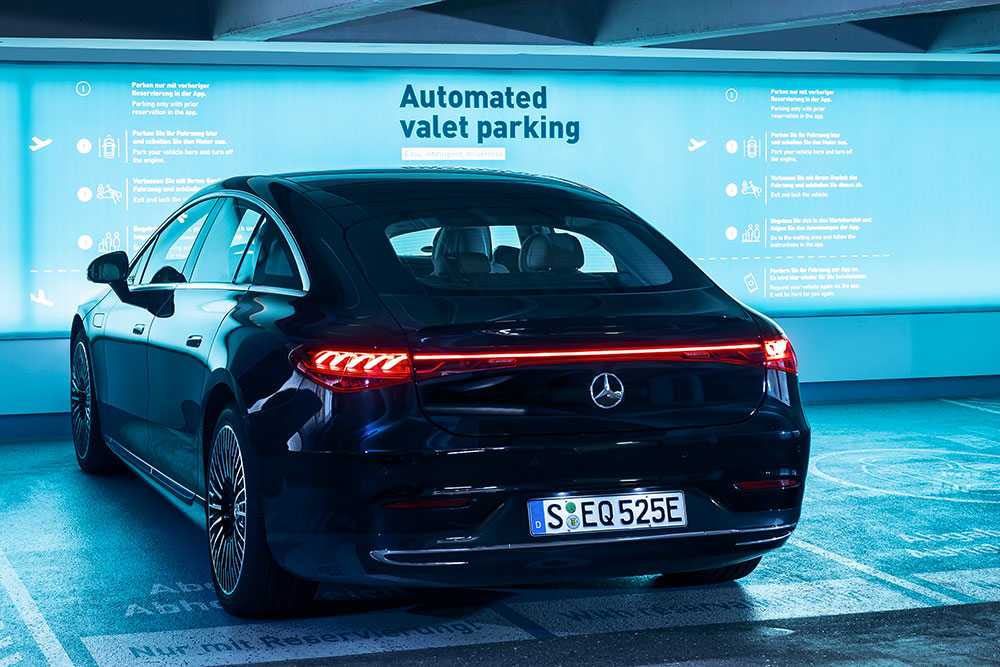Driverless cars a step closer
A new trial approved in Germany brings driverless cars nearer to mainstream use.

Driverless cars have moved a step closer to reality with the approval of a world-first automated valet parking system for certain Mercedes-Benz S-Class and EQS models.
The automated valet parking trial at Stuttgart Airport is claimed to be the world’s first highly automated driverless parking function given official approval for commercial use.
The driverless parking system collects and returns the vehicle completely independently, using Mercedes-Benz S-Class and EQS models equipped with the German car maker’s Intelligent Park Pilot2 feature.
Mercedes-Benz and its technology partner Bosch are presenting the automated parking system trial as a major milestone on the way to automated driving after gaining approval from Germany’s powerful Federal Motor Transport Authority (KBA).
“The world’s first approval for customer use of our highly automated and driverless parking function, developed together with our technology partner Bosch, shows that innovation leadership and ‘Made in Germany’ go hand in hand,” said Markus Schäfer, Member of the Board of Management of Mercedes-Benz Group AG, Chief Technology Officer, responsible for Development and Procurement.
Dr Markus Heyn, member of the Bosch board of management and chairman of the Mobility Solutions business sector, said it would be with driverless parking that everyday automated driving will start.
“Driverless parking is a key aspect of automated mobility,” he said.
“The highly automated parking system we developed together with our partner Mercedes-Benz shows just how far we’ve already progressed along this development path.
“In the future, our aim is to equip more and more parking garages with the necessary infrastructure technology – we plan to do several hundred of them worldwide in the next few years.”
To operate the driverless parking system drivers first use an app to book their parking space.
They then park the vehicle in a predetermined drop-off area and can leave the parking garage.
The parking system will automatically check if the route is clear and that other technical requirements are met, before the vehicle starts automatically and finds its way to its parking space.
When the driver wants to retrieve their car, they summon it via smartphone command and the vehicle makes its way to a predetermined pick-up area.
The process relies on the interplay between intelligent infrastructure supplied by Bosch and installed in the parking garage and Mercedes-Benz automotive technology.
Bosch sensors in the parking garage monitor the driving corridor and its surroundings and provide the information needed to guide the vehicle, while the technology in the vehicle converts the information it receives from the infrastructure into driving manoeuvres.
It’s the latest step in an ongoing autonomous vehicle collaboration between Mercedes-Benz and Bosch, who in 2019 obtained the world’s first permit to operate automated valet parking in the parking garage of the Mercedes-Benz Museum in Stuttgart.
The Stuttgart Airport trial goes beyond that, however, by allowing commercial operation with privately owned vehicles.
In July 2021 a new law came into force in Germany permitting driverless driving in accordance with SAE Level 4 for motor vehicles.
There are six levels of automated driving, with four stating declaring that the vehicle can autonomously handle all traffic situations under certain conditions, with no driver required.
Related topics
Things to note
The information in this article has been prepared for general information purposes only and is not intended as legal advice or specific advice to any particular person. Any advice contained in the document is general advice, not intended as legal advice or professional advice and does not take into account any person’s particular circumstances. Before acting on anything based on this advice you should consider its appropriateness to you, having regard to your objectives and needs.
Insurance Products (excluding Travel Insurance) are issued by RACQ Insurance Limited ABN 50 009 704 152 (RACQI) and arranged by its agent, RACQ Distribution Services Pty Ltd (RDS) ABN 35 116 361 650, AFSL 567130 and RDS' authorised representatives (including RACQ Operations Pty Ltd ABN 80 009 663 414, AR No. 234978 (RACQO). Conditions, limits and exclusions apply. RDS and RACQO are in the RACQ group of companies. One of the companies in the RACQ group of companies has a minority shareholding in RACQI.
RDS and RACQO have not taken your personal objectives, circumstances or needs into account when preparing advice regarding insurance products and you will need to consider whether the advice is appropriate for you. Read the Product Disclosure Statement (PDS) and any applicable Supplementary PDS before making a purchase decision on this product. You can also access our Target Market Determinations on this website. RDS receives a commission from RACQI for the policies it arranges. RACQO receives fees paid for services it provides to RDS. Further details about remuneration are available on request prior to purchasing.
Banking and loan products issued by Members Banking Group Limited ABN 83 087 651 054 AFSL/Australian credit licence 241195 trading as RACQ Bank. Terms, conditions, fees, charges and lending policies apply. This is general advice only and may not be right for you. This information does not take your personal objectives, circumstances or needs into account. Read the disclosure documents for your selected product or service, including the Financial Services Guide and the Terms and Conditions, and consider if appropriate for you before deciding.
Except for RACQ Bank, any RACQ entity referred to on this page is not an authorised deposit-taking institution for the purposes of the Banking Act 1959 (Cth). That entity’s obligations do not represent deposits or other liabilities of RACQ Bank. RACQ Bank does not guarantee or otherwise provide assurance in respect of the obligations of that entity, unless noted otherwise.
RACQ Bank subscribes to the Customer Owned Banking Code of Practice which establishes higher standards than the law requires. The Code reflects modern consumer expectations and developments in approaches to issues such as consumer vulnerability, guarantors, and supporting customers through financial hardship. Please read our Customer Owned Banking Code of Practice page for more information.
RACQ Operations Pty Ltd (ABN 80 009 663 414 AR 000234978) and Members Travel Group Pty Ltd (ABN 45 144 538 803 AR 000432492) are acting as an Authorised Representative of the issuer of the insurance, Tokio Marine & Nichido Fire Insurance Co., Ltd. (ABN 80 000 438 291 AFSL 246 548). Any advice set out above is general in nature only, and does not take into account your objectives, financial situation or needs. Before purchasing any travel products, please consider the RACQ Travel Insurance Product Disclosure Statement (PDS) and the Target Market Determinations (TMDs) that apply to these products. Whilst the PDS outlines the Terms and Conditions of these products, the TMDs outline the intended class of customers that comprise the target market for these travel products. This will allow you to consider which products best suit your objectives, financial situation and needs and consider the products appropriateness to your personal circumstances. TMDs also outline matters involving the distribution and the review of these products. The PDS, Supplementary PDS and TMDs for each travel product can be found here.
